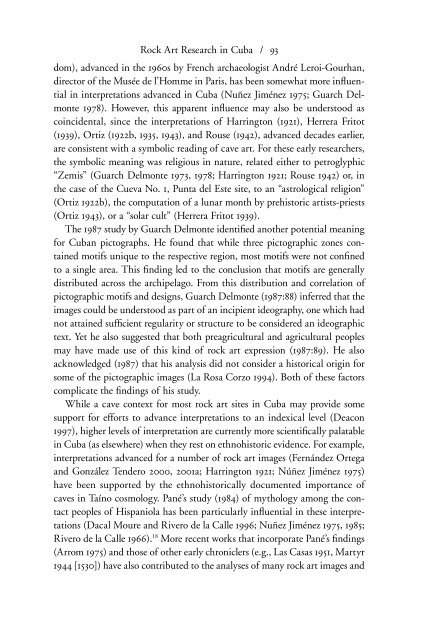Dialogues in Cuban Archaeology
by L. Antonio Curet, Shannon Lee Dawdy, and Gabino La Rosa Corzo
by L. Antonio Curet, Shannon Lee Dawdy, and Gabino La Rosa Corzo
Create successful ePaper yourself
Turn your PDF publications into a flip-book with our unique Google optimized e-Paper software.
Rock Art Research <strong>in</strong> Cuba / 93<br />
dom), advanced <strong>in</strong> the 1960s by French archaeologist André Leroi-Gourhan,<br />
director of the Musée de l’Homme <strong>in</strong> Paris, has been somewhat more <strong>in</strong>®uential<br />
<strong>in</strong> <strong>in</strong>terpretations advanced <strong>in</strong> Cuba (Nuñez Jiménez 1975; Guarch Delmonte<br />
1978). However, this apparent <strong>in</strong>®uence may also be understood as<br />
co<strong>in</strong>cidental, s<strong>in</strong>ce the <strong>in</strong>terpretations of Harr<strong>in</strong>gton (1921), Herrera Fritot<br />
(1939), Ortiz (1922b, 1935, 1943), and Rouse (1942), advanced decades earlier,<br />
are consistent with a symbolic read<strong>in</strong>g of cave art. For these early researchers,<br />
the symbolic mean<strong>in</strong>g was religious <strong>in</strong> nature, related either to petroglyphic<br />
“Zemis” (Guarch Delmonte 1973, 1978; Harr<strong>in</strong>gton 1921; Rouse 1942) or, <strong>in</strong><br />
the case of the Cueva No. 1, Punta del Este site, to an “astrological religion”<br />
(Ortiz 1922b), the computation of a lunar month by prehistoric artists-priests<br />
(Ortiz 1943), or a “solar cult” (Herrera Fritot 1939).<br />
The 1987 study by Guarch Delmonte identi¤ed another potential mean<strong>in</strong>g<br />
for <strong>Cuban</strong> pictographs. He found that while three pictographic zones conta<strong>in</strong>ed<br />
motifs unique to the respective region, most motifs were not con¤ned<br />
to a s<strong>in</strong>gle area. This ¤nd<strong>in</strong>g led to the conclusion that motifs are generally<br />
distributed across the archipelago. From this distribution and correlation of<br />
pictographic motifs and designs, Guarch Delmonte (1987:88) <strong>in</strong>ferred that the<br />
images could be understood as part of an <strong>in</strong>cipient ideography, one which had<br />
not atta<strong>in</strong>ed suf¤cient regularity or structure to be considered an ideographic<br />
text. Yet he also suggested that both preagricultural and agricultural peoples<br />
may have made use of this k<strong>in</strong>d of rock art expression (1987:89). He also<br />
acknowledged (1987) that his analysis did not consider a historical orig<strong>in</strong> for<br />
some of the pictographic images (La Rosa Corzo 1994). Both of these factors<br />
complicate the ¤nd<strong>in</strong>gs of his study.<br />
While a cave context for most rock art sites <strong>in</strong> Cuba may provide some<br />
support for efforts to advance <strong>in</strong>terpretations to an <strong>in</strong>dexical level (Deacon<br />
1997), higher levels of <strong>in</strong>terpretation are currently more scienti¤cally palatable<br />
<strong>in</strong> Cuba (as elsewhere) when they rest on ethnohistoric evidence. For example,<br />
<strong>in</strong>terpretations advanced for a number of rock art images (Fernández Ortega<br />
and González Tendero 2000, 2001a; Harr<strong>in</strong>gton 1921; Núñez Jiménez 1975)<br />
have been supported by the ethnohistorically documented importance of<br />
caves <strong>in</strong> Taíno cosmology. Pané’s study (1984) of mythology among the contact<br />
peoples of Hispaniola has been particularly <strong>in</strong>®uential <strong>in</strong> these <strong>in</strong>terpretations<br />
(Dacal Moure and Rivero de la Calle 1996; Nuñez Jiménez 1975, 1985;<br />
Rivero de la Calle 1966). 18 More recent works that <strong>in</strong>corporate Pané’s ¤nd<strong>in</strong>gs<br />
(Arrom 1975) and those of other early chroniclers (e.g., Las Casas 1951, Martyr<br />
1944 [1530]) have also contributed to the analyses of many rock art images and


















